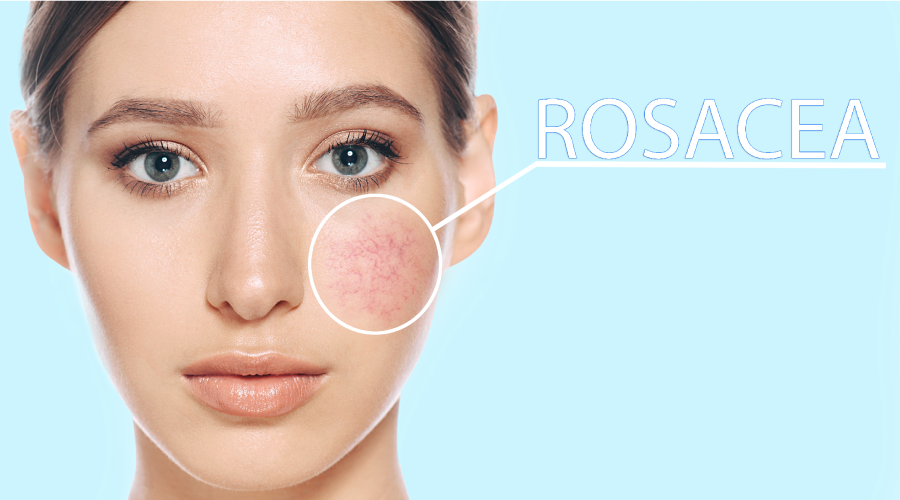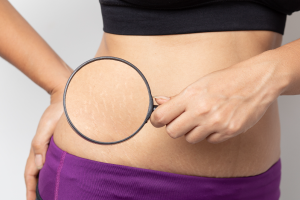

Rosacea is a chronic skin condition that causes the face to blush, and blood vessels become visible. The disease may also cause small, puss-filled bumps on the skin which look like acne. Medical experts and doctors are still unsure of what exactly causes rosacea. However, the cause of rosacea is often attributed to poor elasticity in capillary walls. The capillary walls expand when blood rushes to the face. If they are not sufficiently elastic, then they are unable to go back to their original shape. This results in them being dilated, holding blood cells and giving the face a red appearance. The skin condition is said to be aggravated by poor nutrition, digestive disorders, and nervous disorders. Rosacea involves several regulatory systems of the body and affects family members, which suggests a genetic pattern. It commonly affects people with thin, delicate skin where weakened capillary walls are easily visible. Read on to understand the different ways that will lead to Rosacea treatment.
Types of Rosacea
There are four main types of rosacea:
- Subtype one: also called erythematotelangiectatic rosacea or ETR, causes facial redness, flushing, and visible blood vessels.
- Subtype two: also called papulopustular rosacea or acne rosacea, causes acne-like breakouts. It is known to affect middle-aged women.
- Subtype three: known as rhinophyma, is a rare form of rosacea. This causes thickening of the skin on the nose. Rhinophyma often affects men and is often accompanied by another subtype.
- Subtype four: it is called ocular rosacea. Its symptoms are centred around the area of the eye.
| Types of Rosacea | Area affected | Description |
| Erythematotelangiectatic rosacea | Face | 1. Visible and enlarged small blood vessels 2. Symptoms flare up and disappear |
| Papulopustular Rosacea | Forehead, cheeks, chin | “Whitehead” pustules: 1. Pus-filled blemishes 2. Red/swollen bumps |
| Phymatous Rosacea | Nose | Thickening of skin and it may cause: 1. Scaring, making it bumpy 2. Swollen skin 3. Discoloured skin |
| Ocular Rosacea | Eyes | 1. Dry eyes 2. Sensitive eyes/watery eyes 3. Cysts may form on the eyelids |
How to Get Rid of Rosacea?
Unfortunately, rosacea is not completely curable. However, like most diseases, one can still treat it. Treatments and natural remedies for rosacea may help soothe inflamed skin and weaken the symptoms. Creams, gels, and some procedures have proven to be effective in reducing symptoms of rosacea.
Your doctor may suggest various gels, antibiotics, and procedures based on the signs and symptoms you are experiencing. Rosacea treatment may include the following:
- For mild to moderate rosacea, your doctor may prescribe a gel or cream which needs to be applied regularly. The effects may be visible after just 12 hours.
- Oral antibiotics may be prescribed for moderate to severe rosacea. It is recommended to take these as per the advice of the doctor.
- Isotretinoin may be prescribed for severe rosacea. This is a powerful oral acne drug.
- If you are pregnant or breastfeeding, then inform your doctor before undergoing any treatment for rosacea. During this time, certain drugs like Isotretinoin may be harmful to your baby.
- Laser therapy and dermabrasion are some of the procedures used for rosacea treatment.
What are Some Home Remedies for Rosacea?
Listed below are some of the best home remedies that help with the treatment of rosacea:
1. Honey
Honey has been present in medicinal history throughout the world for centuries. It is infused with anti-microbial qualities and is a natural cleanser. Honey helps soothe the skin when a few drops are applied to the affected area. It also reduces the spread of acne breakouts.
2. Green Tea
Among the most widely consumed beverages in the world, Green Tea is enriched with antioxidants and polyphenols. This minimises swelling, inflammation, redness, and flushing of the skin. It also acts as a protection against UV A and B rays and helps prevent inflammation due to sunlight. A chilled green tea decoction being pressed onto the affected area has proven to be effective and the best rosacea treatment.
3. Aloe Vera
Aloe vera is a self-healing plant, with its leaves repairing themselves when one of them breaks off. Aloe vera’s freshly extracted gel is an excellent moisturiser. It can be used as a pure, herbal moisturiser and is commonly used as a treatment for rosacea.
4. Coconut Oil
Coconut oil is rich in antioxidants and rehydrating properties. It also contains fatty acids such as lauric acids that repair and soothe irritated skin. Use virgin coconut oil to ensure there are fewer additives in your product.
5. Lavender Oil
Various essential oils are used topically for rosacea treatment at home. Applying diluted lavender oil is an effective treatment. It has anti-inflammatory and calming properties that help soothe irritated skin. It is good for all skin types. Lavender oil can be used by mixing one or two drops with water or moisturiser and applying gently to the affected area.
6. Oatmeal
Long known as a treatment for rosacea, oatmeal benefits the skin in several ways. It minimises water loss and strengthens the skin. Having antioxidant and anti-inflammatory properties, it soothes irritated skin. Oatmeal can be applied as a face mask on irritated skin to treat rosacea.
Preventing the Symptoms of Rosacea
Rosacea symptoms can be prevented in various ways. Apply sunscreen daily and don’t expose your skin to direct sunlight for too long. Using only gentle and herbal skin care products as well as applying a moisturiser every day may help. Gently massage your skin in a circular motion. Stick to a cool and soothing diet, like a Mediterranean diet.
Conclusion
Rosacea is not a dangerous illness but since it is a skin disorder, it may cause a person’s insecurities. With proper care and guidance from a doctor, rosacea treatment is possible.




